Uncategorized
Geotechnical engineer and expert in trenchless technology for water and wastewater conveyance
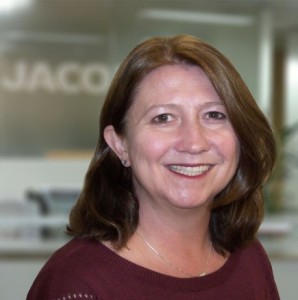 Michelle has more than 18 years of experience in geotechnical engineering, with a particular emphasis on trenchless design and involvement in the water/wastewater industry. From a young age, Michelle enjoyed playing in the dirt, solving problems, and helping people. Today, she feels fortunate to have found a career where she can continue to do all three. She brings a passion for assisting the needs of her clients and their trenchless engineering challenges. Jacobs is excited to have her on the team!
Michelle has more than 18 years of experience in geotechnical engineering, with a particular emphasis on trenchless design and involvement in the water/wastewater industry. From a young age, Michelle enjoyed playing in the dirt, solving problems, and helping people. Today, she feels fortunate to have found a career where she can continue to do all three. She brings a passion for assisting the needs of her clients and their trenchless engineering challenges. Jacobs is excited to have her on the team!
Prior to joining Jacobs, Michelle was a senior geotechnical engineer specializing in trenchless design and construction with GeoEngineers and Staheli Trenchless Consultants. Her trenchless expertise includes horizontal directional drilling, microtunneling, pipejacking, auger-boring, pipe ramming, and pilot-tube microtunneling—just to name a few. In addition to her extensive project experience, she has been active in the North American Society for Trenchless Technology (NASTT), is currently a member of the ASCE subcommittee on Trenchless Installation of Pipelines (TIPS), and is a regular presenter at national trenchless conferences.
Since joining Jacobs, Michelle has been assisting on projects across the nation. Some of the more noteworthy endeavors include:
- Two Design/Build efforts for Miami-Dade County Water and Sewer Department (MDWSD) that involve microtunnel crossings of waterways, railways, and congested intersections;
- An HDD project for a 42-inch diameter installation under the St. Johns River for JEA in Jacksonville, Florida;
- Multiple trenchless projects in Texas for the City of Temple and the City of Austin for water distribution and sanitary sewer projects; and
- The I4 Ultimate project in Orlando, where she is providing senior-level QA/QC for trenchless aspects.
Having spent most of her professional career in the Pacific Northwest, Michelle is thrilled to be able to expand her trenchless expertise to other regions. She finds it exciting to work with regional Jacobs offices that offer experience with local agencies and knowledge of local geology. Michelle is able to share her trenchless technology expertise (risks, benefits, and challenges of trenchless options) with Jacobs engineers across the nation, which ultimately provides clients and owners with the best combination of local knowledge and national experience.
For further information please contact:
Michelle Macauley – michelle.macauley@jacobs.com
Uncategorized
(10/08/15) SAN FRANCISCO— Today the U.S. Environmental Protection Agency recognized the Sonoma-Marin Saving Water Partnership, the Municipal Water District of Orange County, KB Home, Energy Inspectors Corporation, and 13 other winners as WaterSense Partners of the Year for creating, rebating, communicating and educating consumers about WaterSense labeled products, homes and programs.
EPA Region 9 is working with all levels of government, tribes, and NGOs to expand and scale-up improved and sustainable water management in response to the ongoing severe drought in the Pacific Southwest. This includes identifying tools to build long-term resiliency to future water supply shortfalls with key actions such as assisting water utilities identify and address losses from in their water distribution systems, advancing innovation in wastewater recycling, promoting stormwater capture for non-potable use and to replenish groundwater, and working with industry and consumers to conserve water through efficient fixtures and practices.
“EPA is proud to honor WaterSense partners for making a difference in drought-stricken communities,” said Jared Blumenfeld, EPA’s Administrator for the Pacific Southwest. “Our WaterSense partners are helping build stronger, more resilient water systems to meet the challenges ahead.”
WaterSense announced the 2015 Sustained Excellence Award winners, Partners of the Year, and Excellence Award winners today at the WaterSmart Innovations Conference and Exposition in Las Vegas, Nevada. By working together, these water efficiency leaders and more than 1,700 other WaterSense partners have helped Americans save 1.1 trillion gallons of water and $21.7 billion in water and energy bills since 2006.
2015 WaterSense Partners of the Year:
KB Home, headquartered in Los Angeles, Calif., was recognized with a WaterSense Sustained Excellence Award for its continued work building WaterSense labeled homes, for which it previously earned Builder Partner of the Year for four years. In addition to building nearly 100 WaterSense labeled homes in 2014, KB Home also constructed model homes in California featuring innovative water-efficient products, along with graywater recycling systems that provide water for toilet-flushing or landscape irrigation.
Energy Inspectors Corporation, located in Las Vegas, Nev., was recognized as the Licensed Certification Provider Partner of the Year for certifying 100 WaterSense labeled new homes in 2014 and its continued work with KB Home to build even more communities of WaterSense labeled homes. The company also kept its inspectors’ knowledge current through creation of an online training video on the WaterSense indoor and outdoor criteria for homes.
The Sonoma-Marin Saving Water Partnership was recognized as the Professional Certifying Organization Partner of the Year for its Qualified Water Efficient Landscape (QWEL) professional certification program. In 2014, four more organizations adopted the QWEL program and 200 new irrigation professionals were certified. The partnership also updated and promoted a graywater training module.
The Municipal Water District of Orange County, located in Fountain Valley, Calif., was recognized with an Excellence Award for its Sprinkler Spruce-Up campaign as a platform to promote and educate costumers about WaterSense labeled weather-based irrigation controllers and the importance of “sprucing up” irrigation systems.
EPA’s WaterSense program protects the future of our nation’s water supply by offering people a simple way to use less water with water efficient products, new homes and services. In helping to preserve water resources, the important work of the WaterSense program supports the goals of EPA’s Clean Water Rule. And, because saving water also saves energy, the program supports EPA’s Clean Power Plan, which will help communities save energy and reduce greenhouse gas emissions.
Learn more about the 2015 WaterSense award winners, including more information about the award winners in California and Nevada, at www.epa.gov/watersense.
Uncategorized
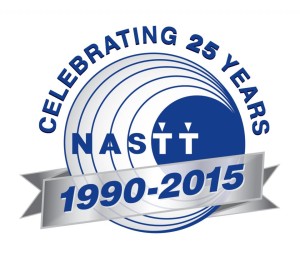
NASTT turns 25 in 2015! What was happening 25 years ago?
On October 4, 1990, Fox TV’s “Beverly Hills, 90210” premiered.
On October 6, 1990, US 67th manned space mission STS 41 (Discovery 11) launches into orbit.
On October 9, 1990, Radio stations around world play “Imagine” honoring John Lennon. (October 9 would have been his 50th birthday)
Check in every Friday in 2015 when NASTT posts more facts about 25 years ago…
Uncategorized
LAKE MILLS, Wisc.– Pipe bursting contractors now have 99 tons of pulling force for their 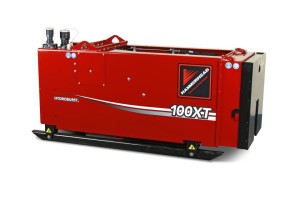 sewer, water and gas line replacement jobs from the new, powerful, compact HydroBurst® 100XT static pipe bursting system from HammerHead Trenchless Equipment. Featuring tethered remote control, the streamlined 100XT pays out rod very quickly due to the pipe industry’s first automated rod spinning assembly and the unique design of its hydraulic cylinders.
sewer, water and gas line replacement jobs from the new, powerful, compact HydroBurst® 100XT static pipe bursting system from HammerHead Trenchless Equipment. Featuring tethered remote control, the streamlined 100XT pays out rod very quickly due to the pipe industry’s first automated rod spinning assembly and the unique design of its hydraulic cylinders.
Alan Goodman is national sales manager for HammerHead Trenchless Equipment ram and burst products. He says that the 100XT might be the only bursting machine some contractors ever need. The unit weighs just 3,200 pounds and is only 39 inches high by 30 inches wide.
“It has the muscle to replace pipes up to 16 inches in diameter,” Goodman said, “yet is compact enough they won’t mind using it for pipes as small as 4 inches.”
The pulling machine’s water-cooled PP4500 hydraulic powerpack with 72.7 hp Kubota engine pumps hydraulic fluid at up to 43.5 gpm and 4,500 psi. In 50-ton mode the unit directs all hydraulic fluid to just two of the cylinders, which then can move twice as fast as in 100-ton mode.
Although some jobs will require access to the machine’s 100-ton capacity, Goodman said, jobs that require 50 tons of pullback or less mean the actual pipe burst will also be done that much faster.
Pull rod used by the 100XT is the same lightweight 2.5-inch, API-threaded rods used by other models. The spinner assembly incorporated on its carriage is rated to 250 foot-pounds. The spinner allows rod to be fed from behind. As the unit is pushing during payout, rod can be added without stopping the machine. The result is that as the unit is pushing during payout, rod can be made up, or tightened, simultaneously.
Putting the 100XT operator on the surface with remote control frees up workspace in the pit for the rod handler, permits the best view for more efficient control of the operation and also enhances overall worksite safety. Lever-actuated controls on the puller itself facilitate initial training and orientation at the machine and provide redundant backup, ensuring job completion if for any reason the remote control cannot be used.
As static pipe bursting specialist for HammerHead Trenchless Equipment, Mark Maxwell helps to train operators on the machine. Maxwell said, “The new unit is so user-friendly and its operating manual so clear that the customer is comfortable using the remote after a little guided instruction from me.” Maxwell said D&D Sewer and Water, a contractor based in Canton, Michigan, who specializes in pipe bursting, was instrumental in the final design. “We asked D&D to rigorously and thoroughly test it in the field,” Maxwell said. “Basically, ‘Go beat this thing up.’ But it failed to fail.”
The HydroBurst 100XT is available from HammerHead Trenchless Equipment or from authorized dealers, worldwide. Authorized dealers can be found on the web at www.hammerheadtrenchless.com or by calling 800.331.6653. (International: + [1] 920.648.4848).
Uncategorized
On July 22, 2015, a 3.5 m (11.5 ft) Robbins Main Beam TBM began a new chapter in its 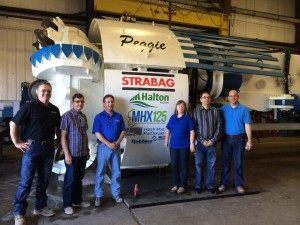 storied 32-year career. Originally built for the Terror Lake project in Alaska, the veteran machine has been used all over the world, most recently in Hong Kong. Including its new 6.3 km (4.0 mi) long tunnel for the Mid-Halton Outfall in Ontario, Canada, the machine will have bored nearly 30 km (18.6 mi) of tunnels since 1983.
storied 32-year career. Originally built for the Terror Lake project in Alaska, the veteran machine has been used all over the world, most recently in Hong Kong. Including its new 6.3 km (4.0 mi) long tunnel for the Mid-Halton Outfall in Ontario, Canada, the machine will have bored nearly 30 km (18.6 mi) of tunnels since 1983.
The machine’s latest endeavor will not be without challenges. The rebuilt TBM has been beefed up for high-capacity tunneling in hard rock. Geology is expected to consist of laminated shale with interbedded limestone and siltstone layers and a maximum rock strength of 120 MPa UCS. “We have kept this a simple, streamlined Main Beam machine, but we modified the cutterhead with larger muck buckets, so material can be moved through it faster,” explained Robbins Project Manager Lynne Stanziale. In addition the TBM was outfitted with fully modernized VFDs, electronics, and high-capacity gearing and motors. The back-up system was also modified to make it more mobile through two 130 m (427 ft) radius curves that the TBM will have to navigate, one in each direction.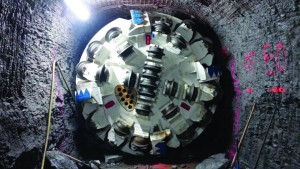
“The concept of using refurbished TBMs bears great opportunities for value-for-money constructors,” said Christian Zoller, Commercial Project Manager for contractor STRABAG. “Our TBM ‘Peggie’ is evidence of that–when well-maintained and professionally refurbished, the lifespan of these machines is extensive. We’re pleased to see that our client Halton Region has the forward-oriented mindset that allows STRABAG to provide its renowned high level of skill and quality, paired with the good value for money that a refurbished TBM yields.”
Contractor STRABAG, who has had several projects in Canada including the epic Niagara Tunnel project, is in charge of the works. In addition to the tunnel, STRABAG had to construct two deep shafts for the launch and exit of the TBM. The scheme involves two sections of tunnel designed to carry treated effluent water from a treatment plant in Oakville into Lake Ontario. The completed system will upgrade water treatment capacity in the Halton Region of Ontario.
The TBM was launched from a 12 m (39 ft) diameter, 62 m (203 ft) deep shaft and is ramping up production, having excavated over 300 m by early September 2015. “An ongoing challenge associated with the tunneling on this project is the requirement to drive the TBM downhill for the first 4 km (2.5 mi) of the tunnel. Keeping the water that infiltrates the tunnel from flowing directly to the cutterhead requires significant effort,” said Terry McNulty, Technical Project Manager for STRABAG.
Management of water inflows is not the only challenge. A portion of the drive will curve to run directly under Lake Ontario for 2.1 km (1.3 mi), though the tunnel is deep enough that it will remain in bedrock. Once the machine has completed its final bore under Lake Ontario, it will be backed out of the blind heading and removed from an 8.0 m (26 ft) diameter shaft in a local park.
“We can already see the potential performance that this TBM will have, once fully assembled and tested. We look forward to the continued support and cooperation with our partner Robbins on this endeavor,” said Zoller. Though the TBM has only recently started up, crews are moving forward with a plan to line the tunnel with mesh panels and ring beams if necessary. A cast-in-place liner will follow on after tunneling is completed in August 2017.
Photo Information:
Photo 1: Officials from the Mid-Halton Region visit the hard-working Robbins Main Beam, nicknamed “Peggie” in the Solon, Ohio, USA manufacturing facility. Photo Credit: Michelle Hill, NASTT.
Photo 2: The Robbins Main Beam TBM has been in service since 1983, and with its new project for the Mid-Halton Outfall, it will have bored nearly 30 km (18.6 mi) of tunnels.
Photo 3: Contractor Strabag lowers the main beam of the Robbins TBM into the 62 m (203 ft) deep launch shaft.
Contact Information:
Desiree Willis
Technical Writer
Email: willisd@robbinstbm.com
Direct: 253.872.4490
29100 Hall Street
Solon, OH 44139 USA
 Michelle has more than 18 years of experience in geotechnical engineering, with a particular emphasis on trenchless design and involvement in the water/wastewater industry. From a young age, Michelle enjoyed playing in the dirt, solving problems, and helping people. Today, she feels fortunate to have found a career where she can continue to do all three. She brings a passion for assisting the needs of her clients and their trenchless engineering challenges. Jacobs is excited to have her on the team!
Michelle has more than 18 years of experience in geotechnical engineering, with a particular emphasis on trenchless design and involvement in the water/wastewater industry. From a young age, Michelle enjoyed playing in the dirt, solving problems, and helping people. Today, she feels fortunate to have found a career where she can continue to do all three. She brings a passion for assisting the needs of her clients and their trenchless engineering challenges. Jacobs is excited to have her on the team! 




